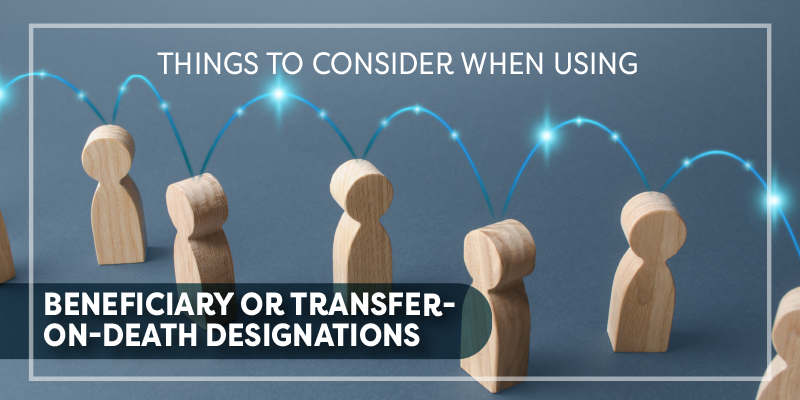
Advisors often focus on big-picture and long-term planning. However, the devil is in the details, and even seemingly straightforward aspects of a plan—such as beneficiary designations—can have profound implications for our clients’ financial objectives and legacy goals.
Beneficiary, transfer-on-death (TOD), and payable-on-death (POD) designations promise a smooth, probate-free handoff of assets that can save time and money. These tools take precedence over conflicting instructions in a will, but they are only as good as the care behind them. They need to be periodically reviewed to avoid being incomplete or out-of-date, which could potentially lead to unintended and detrimental consequences for the client and their loved ones.
Clients may be unaware of when they should consider changing their beneficiary designations and the steps they must take to make these changes. Client education can be extremely valuable in this area and strengthen the client-advisor relationship.
What Can Go Wrong with an Incomplete or Outdated Beneficiary Form
A report from the ERISA Advisory Council looked at best practices for retirement and life insurance planning and ensuring that plan participant intent is carried out. It found that beneficiary designations that do not accurately reflect a participant’s intentions can trigger disputes about who is entitled to the plan benefits following their death. Common disputes described in the report include:
- Participants do not update beneficiary designations prior to their death to reflect significant life events, such as marriage, divorce, death of a loved one, or birth of a child; such an oversight can initiate conflicts among the participant’s loved ones.
- Participants and designated beneficiaries die simultaneously, raising issues about how survivorship rules affect the distribution of benefits and how state law comes into play.
- Changes in service providers, administrators, or other factors could lead to lost or outdated beneficiary designations, resulting in plan benefits not being distributed to the intended beneficiary or requiring a probate administration.
- The plan does not allow the chosen beneficiary designation, creating doubt about who should receive the benefit (e.g., some plans may not allow minors, certain trusts, businesses, or charities to be named as beneficiaries).[1]
In addition to the unintended distribution of assets and disputes, an invalid, missing, or outdated beneficiary designation can result in the need for the accounts and property to go through probate, possibly causing payout delays and raising estate administration costs.
Assets that go through probate may also be subject to claims from creditors, reducing the final amount distributed to beneficiaries. Failure to properly identify or locate beneficiaries can cause further delays in the distribution process.
According to the ERISA report, a unique challenge of maintaining beneficiary designation forms is that they can remain on file for a very long time, sometimes for decades, without review, increasing the likelihood that the original designation is “stale.”[2] This long shelf life can also lead to the designation form being lost, especially when there are changes in plan administrators or service providers and the transfer process is not complete or thorough.
An Advisor’s Role in Maintaining Accurate Beneficiary Designation Forms
Routine tasks such as checking beneficiary designations may not always be the top priority in client relations. Yet it is in the details that we can sometimes make the biggest difference.
Advisors can make it a best practice to review the designations on our clients’ accounts under our management and any life insurance or other products sold to them, including beneficiary forms. Incorporate the following steps into your review process:
- Be proactive. Make it a standard part of your regular client meetings instead of waiting for clients to initiate the beneficiary review.
- Dig into the details. Asking “Is everything up-to-date?” is a conversation starter, not the end of the discussion. Scrutinize the forms and ask specific questions such as the following:
- Are these beneficiaries still the people you want to receive your accounts?
- Are the beneficiaries still living?
- Are they capable of managing the inheritance?
- Are you fine with them receiving an outright distribution, or do you want greater control over how the inheritance passes to them?
- In cases where more than one beneficiary is named, how hard is it to divide the money, and what is the potential for conflict?
- Stress the “why.” Clients need to understand that beneficiary designations are more than routine paperwork. They ensure that the client’s hard-earned money goes where they intend, without undue delays, conflicts, or costs. Describe what can go wrong with an incomplete or outdated beneficiary form, and remind them that these forms take precedence over their last will and testament.
- Explain a trust as an option. For those clients who want more control over how their money is distributed to their loved ones, explain how a trust can provide added protections and flexibility (staggered payouts, for example), particularly when dealing with complex beneficiary situations such as a minor child, a loved one with special needs, or a beneficiary with creditor issues.
- Have them inform beneficiaries. It is not enough to have beneficiary forms filled out correctly. Clients should consider telling their beneficiaries that they are designated to receive certain accounts. Open communication can not only avoid confusion, minimize family disputes, and make for a smoother administration, but uninformed beneficiaries might not know to claim their inheritance, might have their unclaimed inheritance turned over to the state, and could miss Internal Revenue Service deadlines (e.g., 10-year individual retirement account withdrawal rules), triggering penalties or forced distributions.
In terms of tangible advisor benefits, managing beneficiary designations can appear to be a relatively thankless task that does not generate immediate revenue. However, this is an area where you can provide significant value to your clients.
Catching an oversight can solidify your reputation as a diligent, detail-oriented advisor and boost your relationships—and prospects—in the long term. You may also suggest a beneficiary review of their other accounts and products, such as their estate plan.
Call us at 708.448.5169 to discuss additional ways you can provide value to your clients and safeguard their futures.
[1] Advisory Council on Employee Welfare and Pension Benefit Plans (ERISA Advisory Council), Current Challenges and Best Practices Concerning Beneficiary Designations in Retirement and Life Insurance Plans, at 3 (Dec. 2012), https://www.dol.gov/sites/dolgov/files/ebsa/pdf_files/2012-current-challenges-and-best-practices-concerning-beneficiary-designations-in-retirement-and-life-insurance-plans.pdf.
[2] Id. at 4.aregivers/estate-planning/wills-survey.

